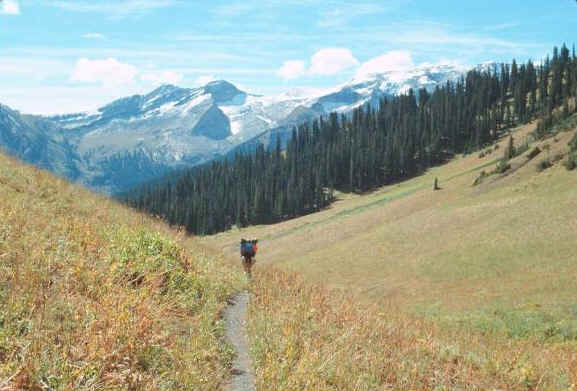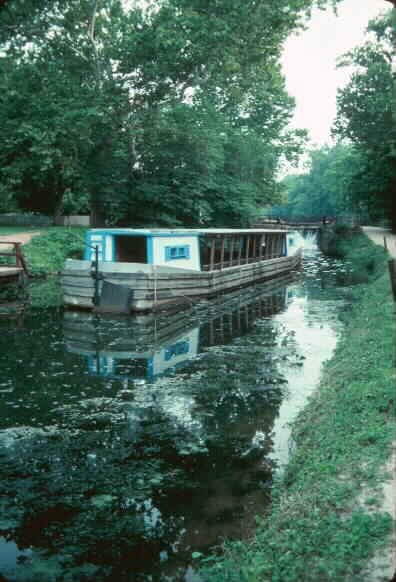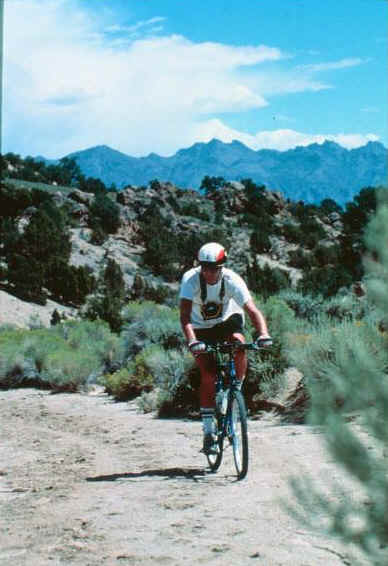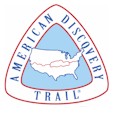THE STORY OF THE AMERICAN DISCOVERY TRAIL
For decades, outdoors visionaries nourished a dream: a foot trail that would take hikers from the Atlantic to the Pacific. Finally, that vision is becoming a reality with the American Discovery Trail.

Twenty years ago, the American Hiking Society sponsored a cross-country trek called HikaNation in which three dozen people backpacked 4,000-plus miles, from sea to shining sea. But they had to follow roads most of the way because there was no route for those who wanted to see America without speeding along a highway cocooned in a vehicle.
Years later, Backpacker magazine and the American Hiking Society (AHS) initiated the American Discovery Trail project to turn the dream of a non-motorized transcontinental route into reality. They wanted to develop a continuous pathway for hikers—and bicyclists, horseback riders, and cross-country skiers—that would link mountains and deserts, high plains and deep canyons, small towns and city greenways, along a route that would stretch from the Atlantic to the Pacific.
Backpacker and AHS called on trails experts in 13 states from Delaware to California to suggest ways to connect their states’ existing east-west trails with other links—logging roads, abandoned rail lines, bike paths, and canal towpaths. And where there were no dirt paths, then the worst roads would be the best—the ones with the most ruts and potholes and the least traffic. All of these links, from trails to towpaths, would be on public lands so people could follow the route as soon as it was scouted, tested, and documented.
The route would connect some of America’s most beautiful wilderness areas with some of its most captivating small towns and exciting city greenways. It would traverse high mountains and high plains, deserts and canyons, prairies and hollows. It would follow historic routes such as the Santa Fe Trail and the Pony Express Trail. It would offer something for every kind of user, from the seasoned trekker prepared for wilderness travel to the casual dayhiker out for a close-to-home stroll.
The Scouting Expedition
While they were gathering trail link suggestions they also gathered a host of corporate sponsors who supplied everything from mountain bikes to long underwear. Backpacker then chose a three-person team—including Ellen Dudley and Eric Seaborg—to explore and test this route.
 The
planners projected an eight-month expedition. It took almost twice that
long—14 months. Trails that were on paper were not on the ground. The maps
sent to the planners showed trail links and dirt roads and even bridges that
were no longer there. The scouting team members were often lost, and often had
to backtrack to find a better route. And this was perhaps the last expedition of
this sort to find its way across trackless wilderness expanses without the help
of such modern-day technologies as cell phones and global positioning systems.
The
planners projected an eight-month expedition. It took almost twice that
long—14 months. Trails that were on paper were not on the ground. The maps
sent to the planners showed trail links and dirt roads and even bridges that
were no longer there. The scouting team members were often lost, and often had
to backtrack to find a better route. And this was perhaps the last expedition of
this sort to find its way across trackless wilderness expanses without the help
of such modern-day technologies as cell phones and global positioning systems.
Ellen Dudley and Eric Seaborg were the two team members who traversed the entire country on this exciting expedition. American Discoveries (Mountaineers Books) is the book they wrote that describes their adventures and misadventures and tells of the beautiful places they saw and the heartwarming people they met during those 14 months. They are donating a percentage of their royalties from the sales of this book to help develop the American Discovery Trail.
Building the Trail
Dramatic progress has been made in the time since the expedition team reached the Atlantic after their 4,835-mile scouting trek. Trails that had disappeared are now once again a reality—and part of the American Discovery Trail—thanks to the hard work of hundreds of volunteers plus government agencies. On many of the problem links, brush has been cleared, trail signs put up, bridges replaced, and trees blazed.
Coordinators in each state are maintaining and marking the trail and assisting trail travelers. Hardworking volunteers along with local, state, and federal government agencies, businesses, tourism boards, and citizens groups are all working to turn the American Discovery Trail into an east-west version of the Appalachian Trail. And services have sprung up along the route to help American Discovery Trail travelers, such as those along a section in West Virginia—the North Bend Rail Trail—where local folks have opened restaurants, bed-and-breakfasts, bike shops, and snack bars.
 The
initial route scouted by the expedition team traversed thirteen states:
Delaware, Maryland (and Washington, DC), West Virginia, Ohio, Kentucky, Indiana,
Illinois, Missouri, Kansas, Colorado, Utah, Nevada, and California. Shortly
after the team finished their scouting expedition, two additional states wanted
to be included, so there is now a northern branch of the American Discovery
Trail across the country’s heartland. It leaves what is now the “southern”
route in Cincinnati, Ohio, and heads northwest, crosses Iowa and Nebraska, and
rejoins the original route in Denver, Colorado.
The
initial route scouted by the expedition team traversed thirteen states:
Delaware, Maryland (and Washington, DC), West Virginia, Ohio, Kentucky, Indiana,
Illinois, Missouri, Kansas, Colorado, Utah, Nevada, and California. Shortly
after the team finished their scouting expedition, two additional states wanted
to be included, so there is now a northern branch of the American Discovery
Trail across the country’s heartland. It leaves what is now the “southern”
route in Cincinnati, Ohio, and heads northwest, crosses Iowa and Nebraska, and
rejoins the original route in Denver, Colorado.
The American Discovery Trail, like the Appalachian Trail, is a work in progress. The original route scouted by the expedition team has changed in several places as better links—such as new rail-trails—have been established.
Today the American Discovery Trail leads to 14 national parks and 16 national forests. It visits more than 10,000 sites of historic, cultural, and natural significance on its 6,300-mile route through 15 states.
Nationally, the trail continues to gain recognition. A bill has been introduced in Congress to include the American Discovery Trail in the National Trails System and to create a new category of national trails—“Discovery Trails”—with the American Discovery Trail being the first so designated. This legislation has passed the Senate unanimously several times but died in House committees.
American Discovery Trail Society
 The American Discovery Trail Society was formed to promote
the development of this trail. This membership and volunteer organization
could use your support! The Society’s
board includes a coordinator for each trail state. Resources available from the Society include an
outline of the trail route called The Explorer’s Guide (Falcon
Press), trail descriptions, and map packets. The Society’s website
provides a wealth of information, including journals of trail travelers:
The American Discovery Trail Society was formed to promote
the development of this trail. This membership and volunteer organization
could use your support! The Society’s
board includes a coordinator for each trail state. Resources available from the Society include an
outline of the trail route called The Explorer’s Guide (Falcon
Press), trail descriptions, and map packets. The Society’s website
provides a wealth of information, including journals of trail travelers:
American Discovery Trail Society; P.O. Box 20155; Washington, DC 20041-2155; (800) 663-2387; info@discoverytrail.org; www.discoverytrail.org.
The Grand Opening
In 2000, the White House honored the American Discovery Trail as one of 16 Millennium Trails.
The American Discovery Trail Society coordinated Grand Opening events and ceremonies in all 15 states along the route in 2000.
The society joined with Backpacker and Ford to sponsor the Ford Adventure Team, a four-member team that traveled across the country to catalyze the grand opening events.
Hit the Trail
Collect some maps and route information and then go out and sample an exciting bit of America’s history and beauty on the American Discovery Trail. A few people have already traversed the entire route but most are opting to try a section at a time, a new state each year until they have crossed the country along this new path. Like the father and his six-year-old daughter who plan to cross the Missouri portion of the American Discovery Trail this summer, pedaling on the Katy Trail along the river route first taken by Lewis and Clark. Like the couple who plans to traverse the American Discovery Trail across Utah’s mountains this fall when the aspens are golden. Like the friends who plan to follow the American Discovery Trail along the Santa Fe wagon route across Kansas when the prairie is lush with springtime flowers.
Take your pick of one of those 15 states on the American Discovery Trail. Whichever one you choose, you’ll make amazing discoveries, experience the kindness of strangers, and find the true warmth and beauty of this country that lies far from its interstate highways and shopping malls.
Links for more information:
American Discovery Trail (official website)
HikaNation - The Father of the American Discovery Trail